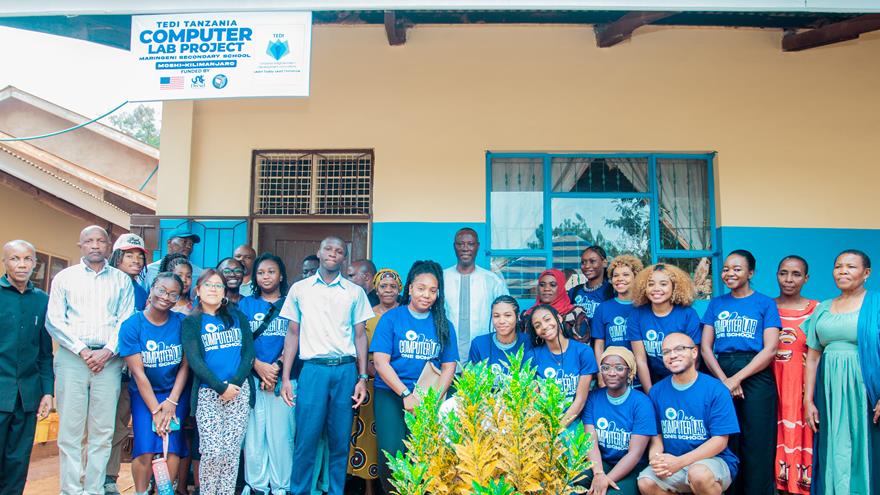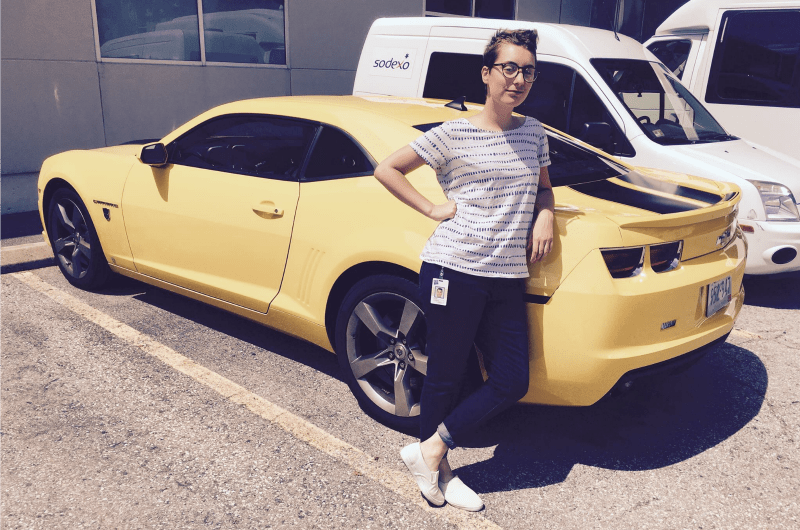A Future-Focused Co-op Finding New Toy Stories
 By Ben Seal
By Ben Seal

- Through Connections and Community, Drexel Course Helps Launch Computer Lab in Tanzania
- Drexel’s Pearlstein Gallery Offers Spring Exhibitions Centered on the Healing Properties of Art and Creative Works
- The First Exhibition of Contemporary Nepali Artists in the U.S. Debuts in Drexel’s Pearlstein Gallery
- Entrepreneurial Game Studio's App Takes Stanzas to the Streets

Drexel senior Gina Lerman alongside Bumblebee, a car from the "Transformers" movies.
This is one of a regular series profiling Drexel students and their co-ops.
Life isn’t all fun and games, but working at a toy company is a step in the right direction. Gina Lerman, a senior product design student in the Westphal College of Media Arts & Design, got to do just that, working for toy titan Hasbro during a six-month co-op that gave her a glimpse into how children will play in the future.
Lerman was in Providence, Rhode Island, last spring and summer as a member of Imbedded Innovation, the small “futuring” group within Hasbro that takes a long view in looking at the toy industry. The team is focused on what kids will be playing with in five years, which new markets will open up, and how to bring “innovation, excitement and new thinking into the traditional toy spaces,” she said. For Lerman, that meant six months learning about every step of the creative process, from conception and design to engineering and marketing.
To develop ideas about where the industry is headed, Lerman dug deep into market research and stayed current on the latest innovations in the world of technology. Part of Drexel’s product design program focuses on design thinking — a creative approach to problem solving that invites designers to turn ideas on their heads. That method translated directly to her work at Hasbro, she said.
“Instead of, when we think of play, immediately going to a traditional toy, we can think about what it means to play and how different people play around the world,” said Lerman. “What influences that? Who’s doing it? Just asking new questions to get new answers. It’s all about throwing away assumptions and trying to be creative and let new things happen.”
The highly collaborative, fast-paced environment at Hasbro gave Lerman a chance to learn just what’s required for a company to take those steps into new creative spaces. She worked closely with the company’s engineers, who help turn the design team’s ideas into reality. The process often requires a healthy dose of compromise, and an understanding that many great ideas won’t make it through the rigors of product development.
“You basically have to sell an idea a hundred times for it to move anywhere in a company,” said Lerman.
She got involved in that process with “experience storyboarding,” which helps to show what a toy might look like once it’s finally in a child’s hands. She would receive a list of features for a toy, then imagine how someone might play with it and draw a comic strip of sorts illustrating the experience. By turning an abstract menu of qualities into a clear story about a child’s relationship with a toy, every member of the Hasbro team could align their thinking about the product to better assess its merits.
Many of the toys Lerman worked on are still under wraps. Such is the nature of forward-thinking design — while most of the industry is focused on what will be stocking shelves in 2018, Imbedded Innovation works on products that are years away from children’s hands. But she did arrive at the tail end of one creation that’s already on the market: Play-Doh Touch is an app that lets users populate a digital world with their own clay creations.
“To see all of the work that went into it, all the design and coding, to make a beautiful, fun product in the end,” was one of the highlights of her time at Hasbro, Lerman said. Along the way, she learned more than she could ever have hoped to know about Transformers — “like, more than any person should know,” she jokingly said. Given that Hasbro has the rights to produce Marvel toys, she was also steeped in the superhero realm.
Now back on campus and with a career in design fast approaching, Lerman is excited about what’s in store. She could see a return to Hasbro in her future, but after six months thinking about the future she’s trying to focus a bit more on the present. She doesn’t have any particular direction she wants to take her design work, as long as it channels her curiosity.
“I just like the process,” said Lerman. “I like the ability to learn new skills and meet new people and always be honing my craft.”
About the Drexel Co-op program: More than 98 percent of eligible undergraduate students at Drexel participate in the co-op program, balancing full-time classes and up to three different internships during their time at Drexel. Students can choose from more than 1,700 employers in 33 states and 48 international locations — plus endless possibilities through self-arranged placements.
Drexel News is produced by
University Marketing and Communications.